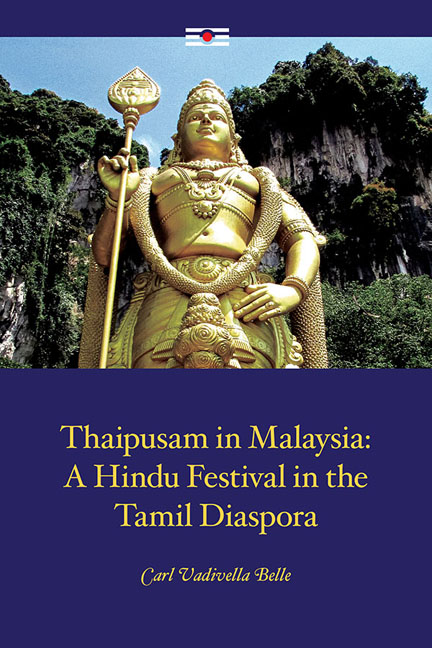Book contents
- Frontmatter
- Contents
- Acknowledgements
- Introduction
- 1 Indians in Malaysia: The Social and Ethnic Context
- 2 Tamil Traditions and South Indian Hinduism
- 3 Colonialism, Colonial Knowledge and Hindu Reform Movements
- 4 Hinduism in Malaysia: An Overview
- 5 Murugan: A Tamil Deity
- 6 The Phenomenology of Thaipusam at Batu Caves
- 7 Other Thaipusams
- 8 Thaipusam Considered: The Divine Crossing
- Conclusions
- Glossary
- Bibliography
- Index
- About the Author
- Frontmatter
- Contents
- Acknowledgements
- Introduction
- 1 Indians in Malaysia: The Social and Ethnic Context
- 2 Tamil Traditions and South Indian Hinduism
- 3 Colonialism, Colonial Knowledge and Hindu Reform Movements
- 4 Hinduism in Malaysia: An Overview
- 5 Murugan: A Tamil Deity
- 6 The Phenomenology of Thaipusam at Batu Caves
- 7 Other Thaipusams
- 8 Thaipusam Considered: The Divine Crossing
- Conclusions
- Glossary
- Bibliography
- Index
- About the Author
Summary
In the Introduction I argued that many scholars who had written about Thaipusam in Malaysia had constructed interpretations of the festival and the associated forms of worship (especially the kavadi ritual) which suggested their own rationales for Thaipusam. It was contended that each of these analyses was superficially convincing, but when subject to close examination relied upon ethnographies that were far from complete. In treating Thaipusam as sui generis, these scholars had failed to situate either the festival or the kavadi ritual within a sufficiently broad cultural or comparative framework. The main objective of this study has been to closely examine Thaipusam from the “inside”, as it were, and to trace the layers of meaning and the recondite vocabularies of this multifaceted and complex festival in terms of its continuing relevance to Malaysian Hindus. In the following paragraphs I will conclude that Thaipusam at Batu Caves, far from being a cultural aberration, a product of time, place and the peculiar circumstances of Hindu Malaysians, is constructed from deep-rooted elements of South Indian culture, and can only be fully comprehended by locating it within Tamil history, philosophies and belief structures, and in particular those associated with the Tamil deity Murugan.
The Indian population in Malaysia can be traced to two major streams of migration; namely, those recruited to serve as a labour force within the colonial economy, and a minority of technical, professional and business migrants attracted by the economic opportunities offered in British Malaya. Labour recruitment produced a variegated population consisting of the general spread of castes below the Brahman level. Skilled and professional migrants included an influential Chettiar merchant/moneylending class, Jaffna Tamils, as well as Malayalees, North Indians, Sikhs and professional and artisan Tamils. The Indian population was characterized by a clear social and vocational chasm between the middle-upper class and the labour force, the former dedicated to maintaining their distance from the despised “coolies”. The social divisions between middle-upper class and working Indians established by the conditions of colonial labour and non-labour migration remain as fixed and potent in contemporary Malaysia as they were in pre-war Malaya.
Since Merdeka, Indian political social and economic weaknesses have been repeatedly exposed, especially in the period following the implementation of post-1969 economic, educational and cultural policies designed to increase social and economic opportunities for Malays.
- Type
- Chapter
- Information
- Thaipusam in MalaysiaA Hindu Festival in the Tamil Diaspora, pp. 354 - 364Publisher: ISEAS–Yusof Ishak InstitutePrint publication year: 2017

